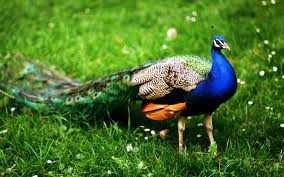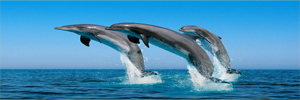NATIONAL EMBLEM
Q1. What is the National Emblem and Official seal of our country - India?
Replica of the Lion Capitol of Emperor Ashoka's Pillar at Saranath.
Q2. What is the quote and script, written on the abacus of the National Emblem?
" SATYAMEWA JAYATE " - meaning "Truth Alone Triumphs" in Devanagari Script.
Q3. From which ancient script, the quote on the National Emblem was taken?
Mundaka Upanishad (concluding part of the Hindu Vedas).
Q4. Whenfrom National Emblem was adopted?
26th January 1950.
Q5. Besides the four headed Lion (of which only three visible), what are the other animals that can be seen in our National Emblem?
A galloping horse and a bull.
NATIONAL SONG
Q6. What is the National Song of India and what does it mean?
"Vande Mataram". (I bow to thee mother or Hail the mother(land)
Q7. When, by whom and in what language the National Song was written and composed?
1876 - by Bankim Chandra Chatterjee, in Bengali and Sanskrit.
Q8. Who set the tune for Vande Mataram?
Jadunath Bhattacharya.
Q9. Vande Mataram was first published in which journal and in which year?
Ananda Matha - 1882.
Q10. When was Vande Mataram first sung in public and by whom?
Rabindranath Tagore in the Calcutta session of INC in 1896.
Q11. Only how many stanzas of Vande Mataram have adopted as National Song and for what reasons?
Only two stanzas of the song have been adopted, as the Islamic community had raised certain objections over thefull song on religious grounds.
Q12. Who translated Vande Mataram into English?
Shri Aurobindo Ghosh.
Q13. How does the English translation of "Vande Mataram" begin and end?
Begins as "Mother, I bow to thee" and ends as "Mother sweet, I bow to thee, Mother great and free".
Q14. What is the Raga in which Vande Mataram has been set in the All India Radio Vesion and also in the Album version of A.R.Rahman?
Desh Raga.
Q15. What unique distinction "Vande Mataram" has in the musical world?
The version of A.R.Rahman, was adjudged as the second best song among 7000 songs from about 155 countries, in a poll conducted by the BBC (British Broadcasting Corporation) in the year 2002.
OTHER INSIGNIAS
Q16. What is the National Bird of India and when was it adopted?
Peacock - adopted from 1964.
Q17. What is the National Aquatic Animal?
Q18. What is the National Animal?
Tiger from 1972. Earlier it was Lion. In the year when "Project Tiger" programme was launched, Tiger has been designated as the National Animal.
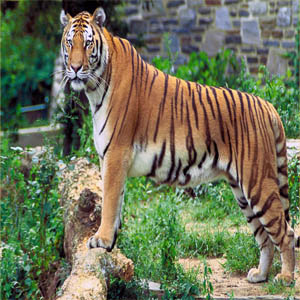
Q19. What is the National River?
Ganges.
Q20. What is the National Treasure?
Fairy Queen Locomotive.
Q21. What is the National Tree?
Banyan.
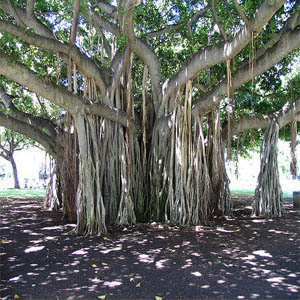
Q22. What is the National Fruit?
Mango.

Q23. What is the National Flower?
Lotus.
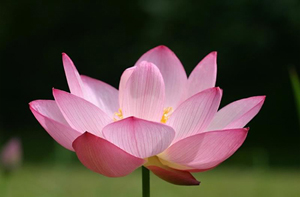
Q24. What is the National Monument?
Taj Mahal.
Q25. What are the National Holidays?
1. Republic Day -26th January;
2. Independence Day - 15th August and
3. Gandhi Jayanthi - 2nd October.
Q26. What is the National Motto?
Satyameva Jayate.
Q27. What is the National Game?
Q28. Kerala Government has recommended in 2009 a poem written by Narayana Guru in 1914 for consideration as National Prayer. What is it?
DAIVA DASAKAM. But the government is yet to accord any such recognition.
Q29. What is the National Language?
Hindi - in Devnagari Script - Made as such by Article 343 of the Constitution for all Government Organizations, Supreme and all High Courts.
Q30. Where and who hoists the National Flag on the Independence Day?
Red Fort - Prime Minister and addresses the people of India.
Q31. Preceding the independence Jawahar Lal Nehru made a famous and important speech to the people of India. What was it called?
"Tryst with Destiny".
Q32. Who administered the oath of office to Jawaharlal Nehru as the first PM of India?
Lord Louis Mountbatten.
Q33. Who was the King of England when India was granted independence?
King George VI.
Q34. When did India become a Republic?
A.` 26.1.1950
Q35. As a Republic, what distinction does India hold?
The first country to become Republic from the Commonwealth of Nations and also the largest democratic republic.
Q36. From where to where the Republic Day Parade is held?
From Raisina Hill near Rashtrapati Bhavan to Red Fort via Rajpath and India Gate. The President unfurls the flag and addresses the nation.
Q37. When from the practice of inviting a foreign head of state to be the Guest of Honour for the Republic Day on a regular basis commenced?
1971. Earlier also some dignitaries have participated as Guest of Honour in the Republic Day but not regularly. But only from 1971 it has been made a practice and regularly followed.
Q38. Who was the first Pakistani Guest of Honour in the Republic Day Celebrations?
1955 -- Governor General Malik Ghulam Mohammad. The other dignitary was Rana Abdul Hamid, Minister of Agriculture, Pakistan, in 1965.
Q39. Who was the Guest of Honour in the First Republic Day Celebrations in 1950?
President Sukarno of Indonesia.
Q40. Who was the first Guest of Honour for the parade at Rajpath?
1955 - Governor General Malik Ghulam Muhammad, Pakistan.
Q41. Who was the Guest of Honour in the Republic Day Celebrations of 2011?
President Susilo Bambang Yudhoyono, Indonesia.
Q42. What is the important award made on the Republic Day Celebrations?
National Bravery Award for Children below the age of 16 along with the Gallantry Awards like Ashok Chakra and Kirti Chakra.
Q43. Closing ceremony of Republic Day Celebration is called?
The Beating Retreat.
Q44. In which year Queen Elizabeth participated as the Guest of Honour in the Republic Day Celebrations?
1961
Q45. In which years two dignitaries participated as the Guests of Honour in the Republic Day Celebrtions?
1968 - Prime Minister Alexei Kosygin of Soviet Union and President Josip Broz Tito of Yugoslavia.
Q46.
1974 - President Josip Broz Tito of Yugoslavia and President Sirimavo Ratawatte Dias Bandaranaike.
Q47. In which year was Nelson Mandela, President South Africa, was the Guest of Honour at the Republic Day Celebrations?
1995
Q48. Who was the Chief Guest at the 2012 Republic Day Celebrations?
Yingluck Shinawatra, PM, Thailand.
Q49. LIST OF GUEST OF HONOURS ON THE REPUBLIC DAY CELEBRATIONS
|
1. 1950 |
President Sukarno |
Indonesia |
|
2. 1954 |
King Jigme Dorji Wangchuk |
Bhutan |
|
3. 1955 |
Governor General Malik Ghulam Muhammad |
Pakistan |
|
4. 1958 |
Marshall Ye Jianying |
P.R.China |
|
5. 1960 |
President Kliment Voroshilov |
Soviet Union |
|
6. 1961 |
Queen Elizabeth II |
United Kingdom |
|
7. 1963 |
King Norodom sihanouk |
Cambodia |
|
8. 1965 |
Rana Abdul Hamid, Minister |
Pakistan |
|
9. 1968 |
PM Alexei Kosygin |
Soviet Union |
|
|
President Josip Broz Tito |
Yugoslavia |
|
10.1969 |
PM Todor Zhivkov |
Bulgaria |
|
12.1971 |
President Julius Nyere |
Tanzania |
|
13.1972 |
PM Seewoosagar Ramgoolam |
Mauritius |
|
14.1973 |
President Mobutu Sese Seko |
Zaire |
|
15.1974 |
President Josip Broz Tito |
Yugoslavia |
|
|
PM Sirimavo Ratwatte Dias Bandaranaike |
Sri Lanka |
|
16.1975 |
President Kenneth Kaunda |
Zambia |
|
17.1976 |
PM Jacques Chirac |
France |
|
18.1977 |
Edward Gierek, First Secretary |
Poland |
|
19.1978 |
President Patrick Hillery |
Ireland |
|
20.1979 |
PM Malcom Fraser |
Australia |
|
21.1980 |
President Valery Giscard d'Estatain |
France |
|
22.1981 |
President Jose Lopez Portillo |
Mexico |
|
23.1982 |
King Juan Carlos |
Spain |
|
24.1983 |
President Shegu Shagari |
Nigeria |
|
25.1984 |
King Jigme Singye Wangchuk |
Bhutan |
|
26.1985 |
President Raul Alfonsin |
Argentina |
|
27.1986 |
PM Andreas Papandreou |
Greece |
|
28.1987 |
President Alan Garcia |
Peru |
|
29.1988 |
President Junius Jayawardene |
Sri Lanka |
|
30.1989 |
Nguyen Van Linh, General Secretary |
Vietnam |
|
31.1990 |
PM Aneroodh Jugnauth |
Mauritius |
|
32.1991 |
President Maumoon Abdul Gayoom |
Maldives |
|
33.1992 |
President Maria Soares |
Portugal |
|
34.1993 |
PM John Major |
United Kingdom |
|
35.1994 |
PM Goh Chok Tong |
Singapore |
|
36.1995 |
President Nelson Mandela |
South Africa |
|
37.1996 |
President Dr.Fernando Henrique Cardeso |
Brazil |
|
38.1997 |
PM Basdeo Pandey |
Trinidad & Tobago |
|
38.1998 |
President Jacques Chirac |
France. |
|
39.1999 |
King Birendra Bir Bikram Shah Dev |
Nepal |
|
40.2000 |
President Olusegun Obasanjo |
Nigeria |
|
41.2001 |
President Abdelaziz Bouteflika |
Algeria |
|
42.2002 |
President Cassam Uteem |
Mauritius |
|
43.2003 |
President Muhammad Khatami |
Iran |
|
44.2004 |
President Luiz Inacio Lula da Silva |
Brazil |
|
45.2005 |
King Jigme Singye Wangchuk |
Bhutan |
|
46.2006 |
King Abudullah bin Abdulaziz al Saud |
Saudi Arabia |
|
47.2007 |
President Vladimir Putin |
Russia |
|
48.2008 |
President Nicholas Sarkozy |
France |
|
49.2009 |
President Nursultan Nazarbayev |
Kazakhstan |
|
50.2010 |
President Lee Myung Bak |
Rep. of South Korea |
|
51.2011 |
President Susilo Bambang Yudhoyono |
Indonesia. |
|
52.2012 |
Prime Minister Yingluck Shinawatra |
Thailand. |
|
53.2013 |
Jigme Kesar Namgyal Wangchuk |
Bhutan |
|
54.2014 |
Shinso Abe |
Japan |
|
55.2015 |
Barrak Obama |
U S A |
|
56.2016 |
Francois Hollande |
France |
|
57.2017 |
Crown Prince Mohamed Bin al Zayed Nahyan |
United Arab Emirates |
|
58.2018 |
|
|
|
59.2019 |
|
|
|
60.2020 |
|
|
Q50. Which country's Head of State was the Guest of Honour for most number of times, in the Republic Day Celebrations?
France - five times - 1976,1980,1998, 2008, 2016
NATIONAL CALENDAR
Q51. Indian National Calendar is based on which era?
Saka Era - Shalivahana Era.
Q52. When from the National Calendar was adopted?
22nd March 1957 = Chaitra 1, Saka, 1879.
Q53. Which king is credited to have initiated the Saka Era?
Satavahana King Shalivahana in 78 AD.
Q54. When from the Saka Era began?
78 AD.
Q55. What is the difference between the Saka Era and the Gregorian Calendar?
78 years.
Q56. National Calendar begins on which date of the Gregorian Calendar?
March 21.
Q57. What is the comparative position of Indian National Calendar versus Gregorian Calendar?
| SAKA ERA |
GREGORIAN |
| 1st Chaitra(30/31 days) |
March 22/21 |
| 1st Vaishaka (31 days) |
April 21 |
| 1st Jyaishta (31days) |
May 22 |
| 1st Asadha(31 days) |
June 22 |
| 1st Sravana(31 days) |
July 23 |
| 1st Bhadra(31 days) |
August 23 |
| 1st Asvina(30 days) |
September 23 |
| 1st Karthika (30days) |
October 23 |
| 1st Agrahayana (30 days) |
November 22 |
| 1st Pausa(30 days) |
December 22 |
| 1st Magha(30 days) |
January 21 |
| 1st Phalguna (30 days) |
February 20. |
